Unit 4 Stories and poems Lesson 21 The Fable of the Woodcutter课件(26张PPT)
文档属性
| 名称 | Unit 4 Stories and poems Lesson 21 The Fable of the Woodcutter课件(26张PPT) | 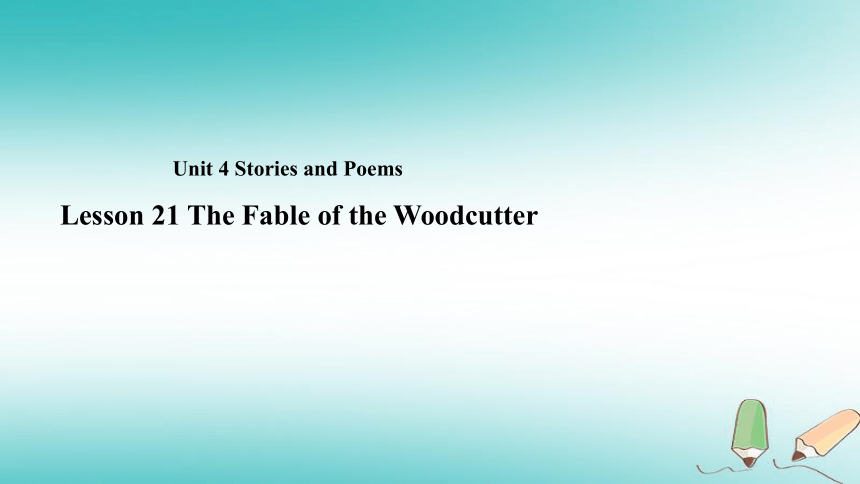 | |
| 格式 | zip | ||
| 文件大小 | 2.8MB | ||
| 资源类型 | 教案 | ||
| 版本资源 | 冀教版 | ||
| 科目 | 英语 | ||
| 更新时间 | 2018-10-12 20:01:05 | ||
图片预览

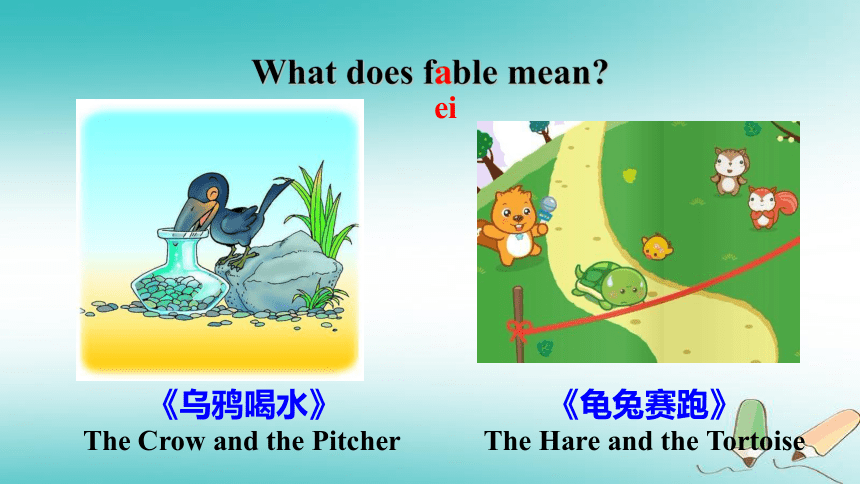


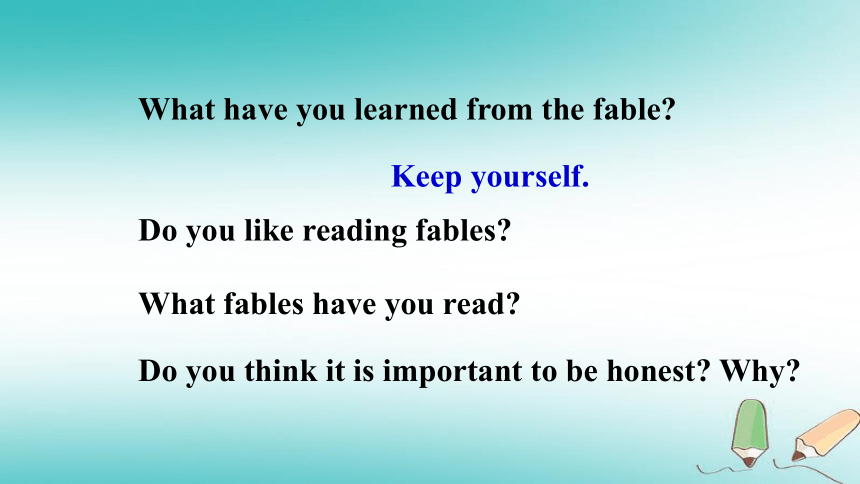
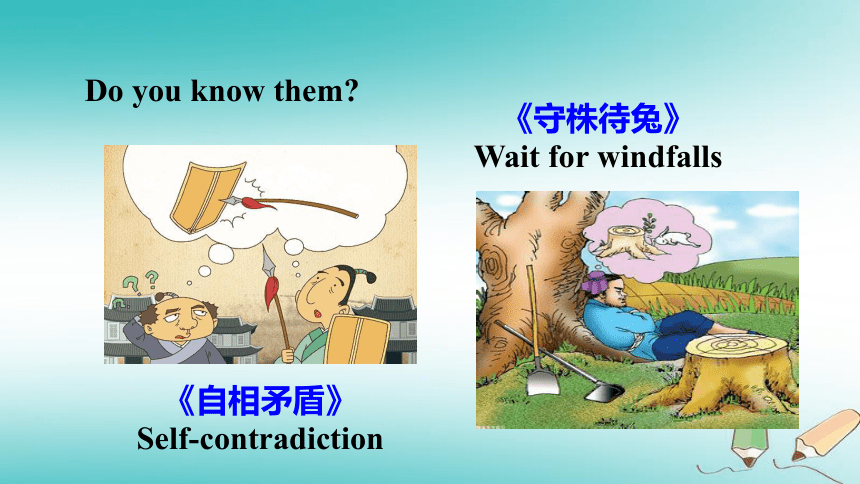
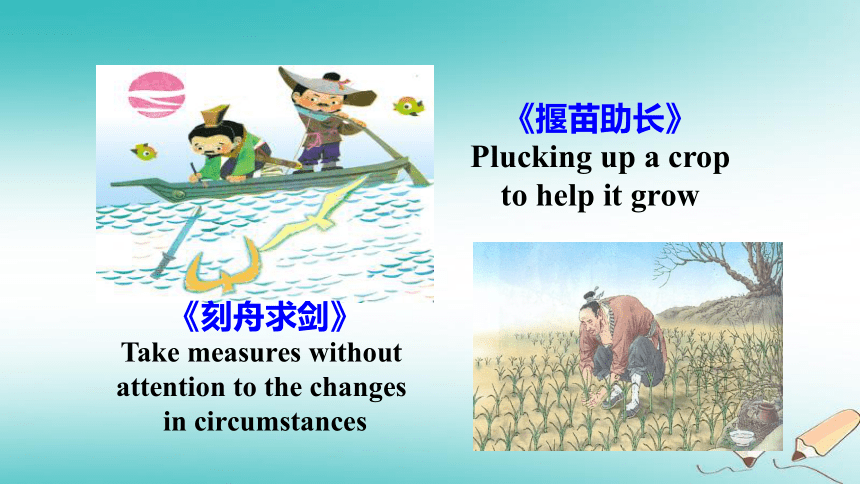
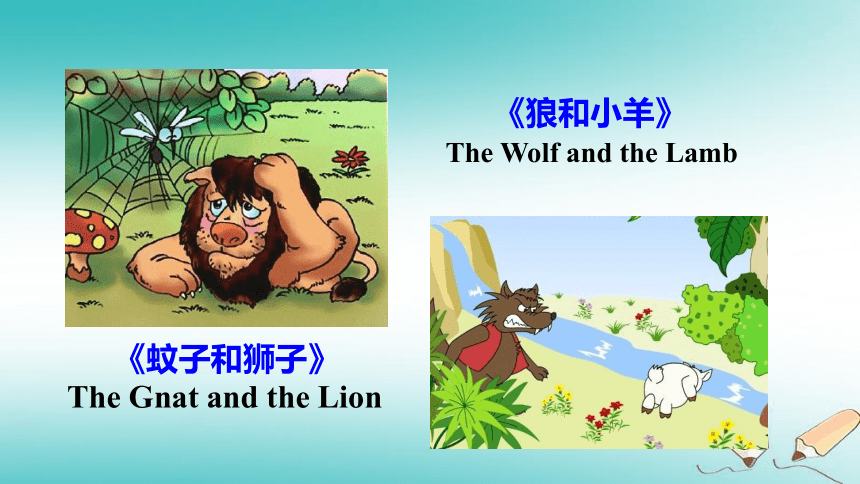
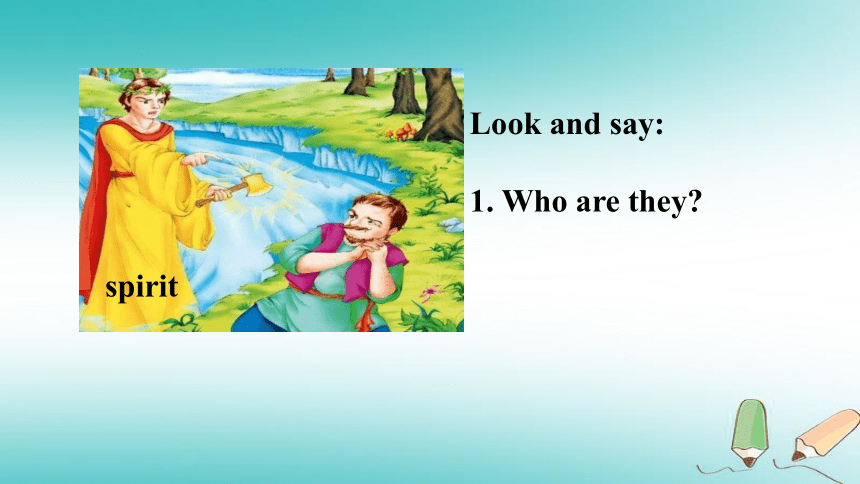
文档简介
课件26张PPT。Unit 4 Stories and PoemsLesson 21 The Fable of the WoodcutterWhat does fable mean?《乌鸦喝水》
The Crow and the Pitcher 《龟兔赛跑》
The?Hare?and?the?Tortoise?ei 寓言是用比喻性的故事来寄托意味深长的道理,给人以启示的文学体裁,字数不多,但言简意赅。该词最早见于《庄子》,在春秋战国时代兴起,后来成为文学作品的一种体裁。
寓言早在我国春秋战国时代就已经盛行,当时一些思想家把寓言当成辩论的手段。为了在政治主张上战胜对方,为了阐明自已的观点,互相责难、辩论,往往取材于古代神话、传说、民间故事或谚语。通过艺术加工,用鲜明生动的抽象的代替议论进行激烈的争辨斗争。有许多成语都是出自古代寓言故事的,比如《亡鈇》、《攘鸡》、《揠苗助长》、《自相矛盾》、《郑人买履》、《守株待兔》、《刻舟求剑》、《画蛇添足》《狐假虎威》、《刻舟求剑》、《掩耳盗铃》等。现在有收录中国寓言的书籍《中国寓言》。
世界各国的寓言作品也很多。世界最早的寓言集是《伊索寓言》,其它比较著名的寓言集或寓言较集中的作品有《克雷洛夫寓言》、《列那狐的故事》、《拉封丹寓言》、阿拉伯寓言《阿拉伯人和他的骆驼》 等。What have you learned from the fable?Keep yourself.Do you like reading fables?What fables have you read?Do you think it is important to be honest? Why?《自相矛盾》
Self-contradictionDo you know them?《守株待兔》
Wait?for?windfalls《刻舟求剑》
Take?measures?without?
attention?to?the?changes?in?circumstances《揠苗助长》
Plucking?up a crop to help it grow 《狼和小羊》
?The Wolf and the Lamb 《蚊子和狮子》
The Gnat and the Lion Look and say:
1. Who are they?
spiritspirit
作可数名词,意为“精灵”,复数形式是spirits。如:
They all call her the little spirit.
他们都把她叫做小精灵。
作不可数名词,意为“精神”。 如:
We should learn this spirit in our work.
我们应该在工作中学习这种精神。Look and say:
1. Who are they?
2. Do you know this fable?
The Fable of the Woodcutter.???spiritaxe[ ?ks ]silver[' s ? l v ? ]What are the made of?diverWhat can he do?[' d a? v ? ]
admit
policy 承认;赞同
原则;政策Listen to the fable and answer the questions:1. Where is the fable adapled from?
2. What is the main idea? What have you learned?
European. We need protect the natura, to be a honest one. get back意为“找回;取回;恢复”
=get back sth.= get sth. backmake/earn one’s living 谋生
He?had to?make?his?own?living? when?he?
was?ten?years old.??
当他十岁的时候,他不得不靠自己谋生。I saw a mouse dive into the hole.
我看见一只老鼠钻进洞里。
dive into 投入;潜入bring back 带回;还回;使记起All library books must be brought back before June 15.
在6月15日之前,所有从图书馆借出的书必须归还。
admit “向某人承认”要搭配介词to。She admitted to me that she was wrong.
她向我承认她错了。“不定冠词+序数词”:相对前一个而言的“又一,再一”。He has seen the book three times, but he wants to see it a fourth time.
那部电影他已看过三次,可他还想再看一次。“定冠词+序数词”:表示按顺序排列的“第……次”。It is the sixth time that I have met her.
这是我第六次和她见面了。
1.What happened to the woodcutter when he was cutting wood beside a lake?
2. Who appeared as the woodcutter cried?
3. How did the woodcutter get back his old axe?
4. Why did the spirit give the woodcutter the other two axes as presents? He lost his axe in the water.A spirit appeared.The spirit dove into the lake and brought back his axe.Because the spirit was so happy with the woodcutter’s honesty.Read the text and answer the questions.Listen to the lesson again. Match each person with the words that describe them.Discuss and showBecause he was honest, he admitted to the spirit that it wasn't his axe.The spirit went down a third time and returned with the woodcutter's old axe.Fill in the blanks with the correct forms of the words or phrases in the box.silver admit make one’s living
come up with dive into1. He_________ to his parents that he broke the
window. They were happy with his honesty.
2. That old lady is very poor. She _______________ by selling newspapers.
3. I’m afraid to________ the swimming pool.
4. He ____________ a fun way to learn math.
5. She wore a ______ chain around her neck.admittedmakes her livingdive intocame up withsilverWork in groups to learn more about fables. You can do one of the following tasks:1. Find the rest of the fable on the Internet. Act it out.
2. Find another fable and act it out. You can search on the Internet or look in books. Don’t forget to find the moral in your fable.1.Listen and read.
2.Finish exercises of this lesson.
3. Recite a fable you like best.
Homework
The Crow and the Pitcher 《龟兔赛跑》
The?Hare?and?the?Tortoise?ei 寓言是用比喻性的故事来寄托意味深长的道理,给人以启示的文学体裁,字数不多,但言简意赅。该词最早见于《庄子》,在春秋战国时代兴起,后来成为文学作品的一种体裁。
寓言早在我国春秋战国时代就已经盛行,当时一些思想家把寓言当成辩论的手段。为了在政治主张上战胜对方,为了阐明自已的观点,互相责难、辩论,往往取材于古代神话、传说、民间故事或谚语。通过艺术加工,用鲜明生动的抽象的代替议论进行激烈的争辨斗争。有许多成语都是出自古代寓言故事的,比如《亡鈇》、《攘鸡》、《揠苗助长》、《自相矛盾》、《郑人买履》、《守株待兔》、《刻舟求剑》、《画蛇添足》《狐假虎威》、《刻舟求剑》、《掩耳盗铃》等。现在有收录中国寓言的书籍《中国寓言》。
世界各国的寓言作品也很多。世界最早的寓言集是《伊索寓言》,其它比较著名的寓言集或寓言较集中的作品有《克雷洛夫寓言》、《列那狐的故事》、《拉封丹寓言》、阿拉伯寓言《阿拉伯人和他的骆驼》 等。What have you learned from the fable?Keep yourself.Do you like reading fables?What fables have you read?Do you think it is important to be honest? Why?《自相矛盾》
Self-contradictionDo you know them?《守株待兔》
Wait?for?windfalls《刻舟求剑》
Take?measures?without?
attention?to?the?changes?in?circumstances《揠苗助长》
Plucking?up a crop to help it grow 《狼和小羊》
?The Wolf and the Lamb 《蚊子和狮子》
The Gnat and the Lion Look and say:
1. Who are they?
spiritspirit
作可数名词,意为“精灵”,复数形式是spirits。如:
They all call her the little spirit.
他们都把她叫做小精灵。
作不可数名词,意为“精神”。 如:
We should learn this spirit in our work.
我们应该在工作中学习这种精神。Look and say:
1. Who are they?
2. Do you know this fable?
The Fable of the Woodcutter.???spiritaxe[ ?ks ]silver[' s ? l v ? ]What are the made of?diverWhat can he do?[' d a? v ? ]
admit
policy 承认;赞同
原则;政策Listen to the fable and answer the questions:1. Where is the fable adapled from?
2. What is the main idea? What have you learned?
European. We need protect the natura, to be a honest one. get back意为“找回;取回;恢复”
=get back sth.= get sth. backmake/earn one’s living 谋生
He?had to?make?his?own?living? when?he?
was?ten?years old.??
当他十岁的时候,他不得不靠自己谋生。I saw a mouse dive into the hole.
我看见一只老鼠钻进洞里。
dive into 投入;潜入bring back 带回;还回;使记起All library books must be brought back before June 15.
在6月15日之前,所有从图书馆借出的书必须归还。
admit “向某人承认”要搭配介词to。She admitted to me that she was wrong.
她向我承认她错了。“不定冠词+序数词”:相对前一个而言的“又一,再一”。He has seen the book three times, but he wants to see it a fourth time.
那部电影他已看过三次,可他还想再看一次。“定冠词+序数词”:表示按顺序排列的“第……次”。It is the sixth time that I have met her.
这是我第六次和她见面了。
1.What happened to the woodcutter when he was cutting wood beside a lake?
2. Who appeared as the woodcutter cried?
3. How did the woodcutter get back his old axe?
4. Why did the spirit give the woodcutter the other two axes as presents? He lost his axe in the water.A spirit appeared.The spirit dove into the lake and brought back his axe.Because the spirit was so happy with the woodcutter’s honesty.Read the text and answer the questions.Listen to the lesson again. Match each person with the words that describe them.Discuss and showBecause he was honest, he admitted to the spirit that it wasn't his axe.The spirit went down a third time and returned with the woodcutter's old axe.Fill in the blanks with the correct forms of the words or phrases in the box.silver admit make one’s living
come up with dive into1. He_________ to his parents that he broke the
window. They were happy with his honesty.
2. That old lady is very poor. She _______________ by selling newspapers.
3. I’m afraid to________ the swimming pool.
4. He ____________ a fun way to learn math.
5. She wore a ______ chain around her neck.admittedmakes her livingdive intocame up withsilverWork in groups to learn more about fables. You can do one of the following tasks:1. Find the rest of the fable on the Internet. Act it out.
2. Find another fable and act it out. You can search on the Internet or look in books. Don’t forget to find the moral in your fable.1.Listen and read.
2.Finish exercises of this lesson.
3. Recite a fable you like best.
Homework
同课章节目录
- Unit 1 Stay Healthy
- Lesson 1 What's Wrong,Danny?
- Lesson 2 A Visit to the Dentist
- Lesson 3 Good Food, Good Health
- Lesson 4 Don't Smoke, Please!
- Lesson 5 Jane's Lucky Life
- Lesson 6 Stay Away from the Hospital
- Unit Review
- Unit 2 Great People
- Lesson 7 What Is the Meaning of Lift?
- Lesson 8 A Universe of Thought
- Lesson 9 China's Most Famous "Farmer"
- Lesson 10 Touch the World
- Lesson 11 To China, with Love
- Lesson 12 Guess My Hero!
- Unit Review
- Unit 3 Safety
- Lesson 13 Be Careful,Danny!
- Lesson 14 Accidents Happen
- Lesson 15 My Helmet Saved My Life!
- Lesson 16 How Safe Is Your Home?
- Lesson 17 Staying Safe in an Earthquake
- Lesson 18 Never Catch a Dinosaur
- Unit Review
- Unit 4 Stories and poems
- Lesson 19 A Story or a Poem?
- Lesson 20 Say It in Five
- Lesson 21 The Fable of the Woodcutte
- Lesson 22 The Giant(Ⅰ)
- Lesson 23 The Giant(Ⅱ)
- Lesson 24 Writing a Poem
- Unit Review
- Unit 5 Look into Science
- Lesson 25 Let's Do an Experiment!
- Lesson 26 Keep the Candle Burning
- Lesson 27 Planet Danny
- Lesson 28 The Study of Living Things
- Lesson 29 DNA—The Story of You
- Lesson 30 Science Affects Us
- Unit Review
- Unit 6 Movies and Theate
- Lesson 31 A movie or a Play
- Lesson 32 Moving Pictures
- Lesson 33 The Fisherman and the Goldfish(Ⅰ)
- Lesson 34 The Fisherman and the Goldfish(Ⅱ)
- Lesson 35 Theatres Are Fun!
- Lesson 36 Making Plays Is Fun
- Unit Review
